UNDER THE PATRONAGE OF THE PRIME MINISTER AND MINISTER OF FOREIGN AFFAIRS, H.E. SHEIKH MOHAMMED BIN ABDULRAHMAN BIN JASSIM AL THANI
As per the country’s budget announced in 2021, projects worth $14.80bln were identified, while these infrastructure-related projects were expected to be awarded from 2021 to 2023
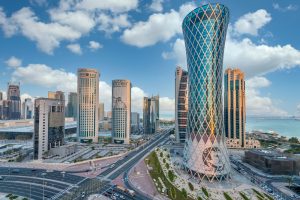
Doha, Qatar: Qatar’s construction sector is anticipated to reach $62.95bn (QR229.19bn) in 2024 and is expected to amount to $97.42bn (QR354.68bn) by 2029, growing at a compound annual growth rate (CAGR) of 9.13 percent during the forecast period.
The report also mentioned that Dentons, a global law firm operating in Qatar listed ‘The Blue Line’, as an expansion of the existing Doha Metro network.
This will be carried out as part of the second phase of the expansion of the Doha Metro Project.
“The second of these projects, the multibillion-dollar Sharq Bridge, will likely construct a three-part bridge with underwater tunnels joining it to connect Katara Cultural Village to Hamad International Airport. Dentons was ranked as the fourth-largest law company in the world by revenue for the fiscal year 2021, with gross sales of $2.9bn (QR10.56bn)”, it reported.
Over the past decade, Doha has swiftly enhanced its infrastructure due to the hosting of global events, making Qatar one of the most sought-after travel hubs in the region.
The major highlights of the well-built infrastructure include cutting-edge highways, stadiums, a metro system, and universities among others.
Analysts at the portal noted that the government’s vital contribution in boosting the construction sector’s growth is the key to global success.
As per the country’s budget announced in 2021, projects worth QR53.9bn ($14.80bn) were identified, while these infrastructure-related projects were expected to be awarded from 2021 to 2023.
However, Qatar’s government aims to develop infrastructure and diversify the economy and has taken initiatives to open economic free zones attracting corporations from across the globe.
The report underscored that “The endorsement of new laws regulating public-private partnerships (PPPs) is expected to attract private sector investment in developing infrastructure, educational institutes, and healthcare projects, hence supporting industry growth during the forecast period.”
It further elucidates that the projects and investments carried out in the transportation sector will also foster growth during the forecast period.
On the other hand, Qatar’s centralises its focus on developing into a more significant global transportation
hub.
“The Qatari government has identified several urgent projects for the medium term, earmarking QR54bn ($15bn) for these. In the second quarter of 2021, spending on major infrastructure projects totaled QR15bn ($4bn), or 20.8 percent of the state’s spending budget,” the report added.
Research and Markets in its latest report underscored that Qatar’s various commitments including hosting the 2022 FIFA World Cup, envisioning National Vision 2030, and its ambition to host the Asian Games in 2030, driving the country towards an impressive array of infrastructure and industrial projects.
Other initiatives such as the 2050 Transport Plan offer Qatar - 22 new projects worth a total of $2.7bn (QR9.83bn), which was announced last year.
Source credit: Zawya
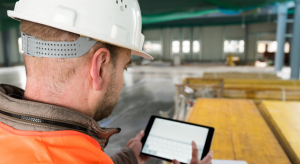
These investments in innovations pay off significantly; research shows that firms that are rated as “digitally savvy” outperform companies by as much as 48% on revenue and 15% on net margin. And this is true across many fields, including AEC.
Research also show that when asked to self-assess, 25% of businesses overate their ability to use data effectively and a whopping 80% of construction businesses are classified as beginner or emerging levels of data capabilities.
There’s never been a more exciting time to be a part of the construction industry. As it continues to change at an accelerated pace, innovations will bring about even more developments and advancements. Here are 10 innovations we believe will shape the future of the industry as we know it today.
1. AI and Machine Learning
Optimized workflows are essential to well-running projects and teams in the AEC industry. However, due to the complexity of construction, workflows have the tendency to be disconnected and manual in nature. The three most significant areas within optimized construction workflows are communication, data, and transparency. AI is making it easier to succeed across all three of these areas, resulting in greater productivity and profits. The fact that Construction Management Association of America (CMAA) proclaimed AI has the potential to increase industry profits by 71% by 2035 doesn’t hurt either.
Machine learning is helping construction pros optimize their workflows and aid decision-making. Predictive analytics is quickly establishing its foothold in the construction industry’s core stack of technology tools. By leveraging current and historical data as well as machine learning, companies can make predictions about future outcomes. These predictions can then be used to make more informed decisions and strategize next moves. Research has also shown that data leaders in construction are 7x more likely to be using AI and machine learning.
Predictive analytics and machine learning are especially valuable in today’s world of complex construction projects and operations. Companies need a precise way to mitigate risks, take advantage of opportunities, and prepare for challenges. This information also gives workers the freedom to focus on higher-value activities that are more likely to move the needle.
BAM Ireland is an excellent example of this benefit. The multinational construction company leveraged Construction IQ, powered by Autodesk AI, as its predictive analytics tool for all projects. Doing so led to a 20% improvement in on-site quality and safety and a 25% increase in time spent on high-risk issues.
Some construction AI innovations are even more subtle. For instance, another tool, AutoSpecs, allows you to find and track submittal items that may not have been added to the specification. The suggested submittals tool compares your current project specifications with historical project data and recommends potentially missing items to enhance accuracy and mitigate risks associated with overlooked details.
2. Resource and Workforce Management Software
Managing resources and a workforce are massive expenses for construction companies. Effective workforce management can help companies keep operations running smoothly, optimize resource allocation, and avoid unexpected expenses as well as delays.
Today, more companies are turning to software platforms to bring more efficiency and actionable analytics to their workforce, whether they be remote, on-site, large, or small.
Construction innovations in workforce management solutions include predictive tracking, forecasting, and mobile-first interfaces. These solutions remove many of the manual processes that come with resource planning.
Bridgit Bench is a workforce planning solution built for contractors to track pursuits, project changes, and forecast workforce needs. Project teams can push awarded and opportunity projects from Autodesk Construction Cloud to Bridgit Bench, keeping projects up to date as changes are made.
One tool, Riskcast provides a way for crews to easily capture labor, equipment, and production plus more, without multiple systems and complex spreadsheets. Teams can sync real-time data into Autodesk Cost Management Performance Tracking to see actuals vs. planned.
Solutions like these allow companies to access metrics and forecasting analytics to better allocate resources to the right projects at the right time. Workforce management solutions are especially important in our current economy, where volatile markets require firms to be as precise and efficient in their operations as possible.
3. The Next Wave of 3D Printing
3D printing has long been cited as one of the top modern construction innovations. However, its future is even brighter these days as the technology moves from a novelty to an emerging industry standard.
With the right implementation strategy—and some creative thinking—3D printing can help speed up projects, make materials more accessible, and enable you to create beautiful designs.
As Stephan Mansour, a 3D Printing & Emerging Technology Advisor at MaRiTama Ltd points out, “Everything can be 3D-printed; it’s just a matter of how far you want to go, how scalable it is, and how much money you’re going to put in.”
In terms of use cases, you can 3D print design elements like facades to make them more intricate and detailed. 3D printing can also be used to print parts, fixtures, and furniture for your building. This is particularly useful when you’re dealing with supply shortages or when you’re working in a remote area. Rather than waiting weeks or months for the materials you need, you can print them within a few hours or days.
We can expect to see 3D printing technologies continue to mature and grow in the future. As companies look for ways to improve quality control, address skilled labor shortages, and explore advanced designs, 3D printing will be here to help them make it a success.
4. AR, VR, and the Metaverse
Extended Reality (XR) serves as the encompassing term for a spectrum of captivating and interactive technologies, including Virtual Reality (VR), Augmented Reality (AR), and Mixed Reality (MR). These transformative experiences are accessible through various devices, ranging from mobile devices to VR headsets. The allure of XR lies in its ability to seamlessly immerse individuals in the digital realm in real-time.
This technology plays a pivotal role in revolutionizing Architectural, Engineering, and Construction (AEC) workflows as highlighted by the announcement of Autodesk Workshop XR, an immersive design review workspace. The evolution of XR is swiftly paving the way for more impactful and efficient work processes. With innovations like Workshop XR, AEC teams are discovering new avenues for issue tracking, error prevention, and enhanced spatial understanding, ultimately improving workflows and integration.
The increasing adoption of XR signifies a paradigm shift in how we approach work, collaboration, and project success. This dynamic environment enables teams to scrutinize and problem-solve within their 3D models in a 1:1 scale, fostering a level of interaction that transcends traditional computer screens.
Businesses—particularly those reliant on cross-departmental collaboration—stand to gain enormous benefits from extended reality solutions. Autodesk Workshop XR, with a connection to Autodesk Construction Cloud through Autodesk Docs, facilitates real-time collaboration within Revit or Navisworks models, making XR a driving force in the AEC industry’s technological wave.
5. Sensor Data
Tracking the various components of your business—including manpower, jobsites, and equipment—is essential. Proper monitoring aids project planning, promotes smoother operations, and ensures compliance with safety and worker regulations.
Here’s the good news: thanks to construction sensors and IoT technology, keeping an eye on the many moving parts of your projects is easier than ever. There are various solutions in the market that can enable you to monitor site conditions, track materials through the supply chain, improve worker safety, and empower better facility management.
Forward-thinking firms are also using sensors to forecast and prepare for future events. “With the use of sensor data and Forge as a software foundation, we are able to predict future product failures,” explains Chris Schoneveld, BIM Manager at Alkondor Hengelo.
“So for a maintenance task, we could analyse the use curve of a building and protect our products against future failures. And doing multiple tasks on a single maintenance job benefits our company’s eco footprint due to a minimization of traffic movement.”
6. Digital Twins
Digital twins is certainly a buzzworthy term, but what benefit does it have for the construction industry? As it sounds, a digital twin is a digital replica of a physical entity, including its potential and current assets, systems, data, processes, workflows, people, and devices. In the context of construction, building out a digital twin from the very start is significant to better understand a physical structure for future operations.
Having a duplicate source of a physical structure allows workers to assess, manipulate, and optimize the building. As they analyze the digital twin, they can uncover potential means of creating efficiencies, developing safety protocols, reducing risks, and improving quality. Digital twins also enhance BIM by serving as a digital thread, connected directly to a physical structure.
Since almost 80% of a building’s lifetime value is realized during operations, the data and insights provided by a digital twin helps owners better maintain their facilities, streamline operations, and improve capital planning.
You can also use digital twins to determine if a built asset is meeting certain KPIs and metrics. “If you have certain sustainable goals, you’ll be able to see if you’re achieving them. If you have equipment and want to measure mean time between failure, having a digital twin helps you do that,” explains Bob Bray, Senior Director & General Manager for Autodesk Tandem.
It can also help owners strategize for the future. As Bob points out, “A digital twin gives you the knowledge to inform, predict, and look at future decisions based on how that asset is performing in the real world.”
Lastly, the advantages of digital twins are especially relevant during times of social distancing, remote work, and travel restrictions. Essential information about a property is readily accessible with a digital twin, avoiding the need to travel or even leave a home office.
Check out Episode 59 of the Digital Builder podcast to learn more about Digital Twins.
7. Truly Connected Construction
Simplicity in construction? It might not be a buzzword, but we’d argue that simplicity is the lifeblood of the most powerful of innovations. When data, workflows, and technology connect, they’re all the more powerful. Apple is a key example of this fact. The same information flows seamlessly between the company’s iPhones, iPads, and MacBooks. These harmonious connections keep things simple and effective.
We see the same concepts play out in connected construction. Construction companies often have to deal with information silos and paper-dependent processes. These challenges are exacerbated by the massive volumes of data and resources that make up the industry. For stakeholders to work efficiently on projects, they need a solid foundation, a single source of truth.
This foundation can be built and maintained with connected construction. Connected construction equates to integrated and connected data, workflows, and technology. It brings information, processes, and people together in one common data environment. It powers effective decision-making, whether they occur during daily operations or as part of a long-term strategic plan. For companies that genuinely want to empower their people to make the most informed decisions possible, connected construction is the answer.
8. Advanced Takeoff and Estimating Tools
The days of relying solely on spreadsheets to put together quantity takeoffs, estimates, and bids, are over. Or at least, they should be. The rise of advanced tools in preconstruction are helping construction pros implement robust bidding and estimating processes so they can focus more on winning more business and reducing risk.
Modern takeoff, estimating, and bidding solutions work in the cloud, enabling you to view and manage bids and estimates from anywhere. These tools also help connect data and teams on one platform, leading to better collaboration and accuracy. And thanks to automation and 3D visualization, you’re able to work faster, produce competitive bids, and ultimately win more work.
Autodesk Takeoff helps contractors easily perform 2D and 3D quantification and ProEst’s estimating solution helps translate project scope into material, labor and equipment costs to generate accurate project estimates. From there, contractors can use BuildingConnected’s bid management solution to choose the right builder for every project from the largest crowd-sourced construction network, reducing risk and protecting the bottom line.
9. BIM Beyond Design
BIM, or building information technology modeling, is widely used in the design world but is often seen as complex and technical outside of it. However, BIM doesn’t have to be complicated. By sharing models between the design department and the field, BIM can be a simple and effective communication tool.
There are many advantages to facilitating BIM access in the field. When models are distributed as PDF documents, valuable BIM data can be lost. By using BIM in the field, teams can improve communication, increase data visibility, and reduce rework costs.
According to John Lim Ji Xiong, Chief Digital Officer, Gamuda Bhd, “In 2024, I think construction industry trends will morph from BIM and 3D modeling to more data-driven topics such as building dashboards, AI, and managing project data. BIM has become something that is mature in the industry and is a requirement in a lot of tenders. However, in the drive to modernize and improve, construction companies will be looking to drive efficiency and transparency through data in order to build better projects.”
Expanding the use of BIM beyond design streamlines communication, provides a richer view of construction documents, promotes safety and reduces rework. By keeping design and field teams aligned through BIM, collaboration improves, and work gets done faster.
Furthermore, new AI innovations open even more opportunities for BIM. “This year, we’ll see greater momentum and interest from the industry as firms leverage AI-driven technologies to automate tedious tasks, more deeply analyze information, and augment decision-making,” says Jim Lynch, Senior Vice President and General Manager, Autodesk. “Particularly, the integration of BIM with AI poses new and exciting opportunities. BIM’s rich data, paired with machine learning, can enable firms to improve efficiency and make smarter decisions beyond just the design phase of a building.”
It’s time to rethink the role of BIM in construction. BIM is not just a design tool every team can use to deliver high-quality work and improve collaboration throughout the construction lifecycle.
10. Robotics
The continued adoption of robotics in construction is another significant development that will shape the industry’s future. However, construction companies face barriers in implementing these technologies including cost of entry and a lack of skills with these specific technologies within teams
On an episode of the Digital Builder podcast, Brooke Gemmell, Emerging Technology Partner at Skanska said, “We’re starting to see so many more robotic applications. I think one thing that may be a misconception is just how readily available they are on projects. Most of the tools out there are only being piloted on a select few projects because we’re still learning how can we really use these and what’s the biggest impact for these tools.”
To overcome these hurdles, companies can start with more mature technologies like drones and offsite prefabrication. They also can invest in training programs and partnerships with technology providers to improve their workforce. Brooke believes there is already a strong appetite from the workforce to do so, “I’ve been on a lot of project sites where we’ve had robotic solutions deployed, and first off, people are really excited about it. They want to learn more and they want to engage.”
Collaboration and communication with technology providers is crucial. By sharing specific needs and challenges, construction companies can shape the development of tailored AI and robotics solutions. It is also beneficial to learn from industry leaders who have effectively incorporated these technologies.
By embracing AI and robotics, construction companies can unlock productivity, efficiency, and safety benefits. These technologies will greatly improve workflow, optimize resource management, and enable faster project delivery.
“Robots are helping people go home earlier, less tired, and with less strain. We’re also taking people out of dangerous situations and using robots in those places,” added Brooke.
Moving Innovation in Construction Forward
The construction industry is truly evolving right in front of our eyes. We’re confident these 10 construction innovations will prove to be especially valuable in the industry today and in the future.
Source Credit: Autodesk
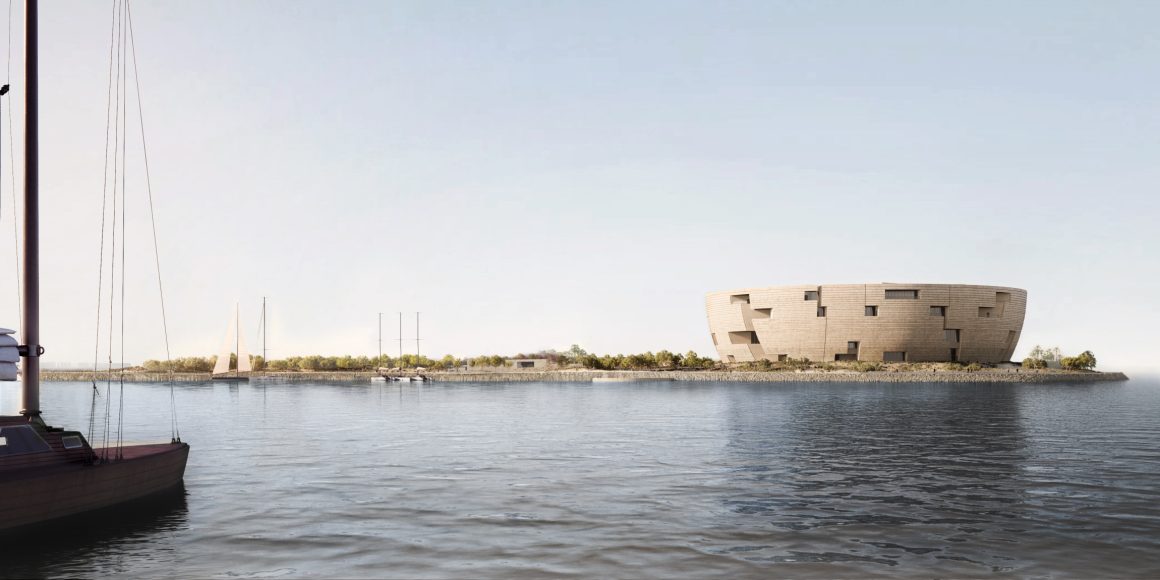
Construction on the new Lusail Museum is expected to commence later this year in Qatar. Located on Al Maha Island in Lusail just north of Doha, the museum will showcase the story of Sheikh Jassim bin Mohamed bin Thani, the founder of Qatar.
According to a CNN report, the museum, promises an architectural marvel with its striking circular design, poised to stand 30 meters tall across five expansive levels.
This structure will span 11,000 square meters, situated on a site vastly exceeding its footprint, and aims to serve as a dynamic space for art exhibitions and global discourse.
Lusail, located approximately 10 miles north of the Qatari capital, Doha, has been under rapid development since 2006.
The city, which hosted the 2022 FIFA World Cup final in the iconic Lusail Stadium, is renowned for its architectural splendours, including the Katara Towers. The completion of the city is anticipated to accommodate up to 200,000 residents. The museum’s design, inspired by Muslim architecture and the natural surroundings, incorporates the crescent shape prevalent in Islamic culture.
Jacques Herzog, the project’s lead architect from the Pritzker Prize-winning Swiss architectural firm Herzog & de Meuron, highlighted the design’s intent to foster a sense of discovery and imagination among visitors.
Herzog & de Meuron, known for their work on the Tate Modern in London and the Beijing National Stadium, aims to integrate the museum seamlessly into Lusail’s landscape and the broader natural elements of sand, rock, and sea.
Source credit: Doha News
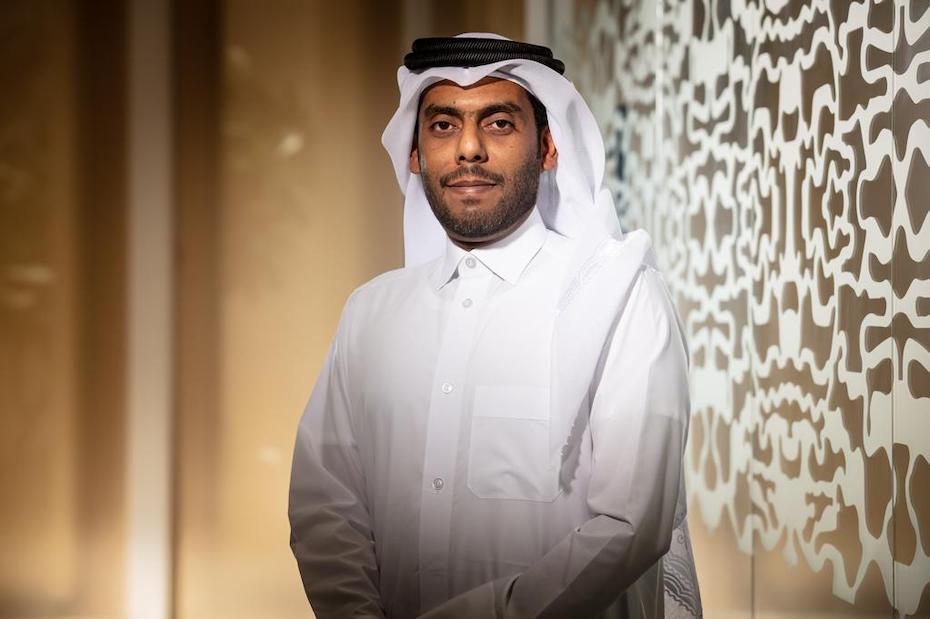
Written by Ali Al Kuwari - CEO of Qatar-based Msheireb Properties.
Sustainability is no longer the buzzword it once was, tagged onto the end of a project as an afterthought because it sounds nice but essentially, means nothing.
It’s no longer a buzzword at all, because today, it is a way of living that has taken hold of the public consciousness and the way that people from all walks of life go about their daily business: from the food we eat to holiday choices, and almost everything in between. The expectation from consumers in pretty much any industry, anywhere around the world, is that sustainability will not only have been considered, but delivered, across the spectrum of products, services, and ideas.
Thus, not only is sustainability good for business, but it is – of course – good for the planet as well. Images of wildfires destroying villages, and towns, and coming very close to cities across the Northern Hemisphere – from Greece to Hawaii – over the summer must be seen as a sign that we all need to do more to live smarter, and more sustainably, and in so doing, to limit our impacts on the natural environment around us.
But how can we do that? Isn’t the damage already done, as this summer has proven?
No. Quite the opposite and it is right now that we must all, collectively, act – before the devastating scenes of the past summer become the norm.
Sustainability in the construction industry means looking backward, as well as looking forward. There is much we can learn from the way that our ancestors tackled the same challenges we grapple with today before they had access to all of today’s technology, and the latest innovation. Then, we can deploy this technology and innovation to track our progress and change to achieve even greater efficiencies.
In our industry and our region, that means looking at the way our ancestors overcame issues of extreme heat in summertime, by being more considerate about how they positioned buildings in relation to each other to provide natural shading and to capture the cool breezes. They didn’t have the luxury of flicking a switch and having an air conditioning unit roar into life, and within new projects, there could be less need to do that too, simply by adopting simple, proven methods like this.
Wind towers are another ancient cooling system a common sight on many traditional buildings throughout the region. They work by funneling hot winds from outside, inside to the lower floors, where the air is cooled naturally, and then released inside the building. So long as the wind is blowing – which it often is over summer – the airflow will naturally keep the occupants cool inside. Another much-tested approach is the use of high-dome rooves, which serve a very real purpose, aside from their aesthetic. This roof style helps shade the rest of the building, providing a natural cooling aspect when the sun is shining.
Embracing smart design, technology and sustainability are not unique to Qatar. In the MENA region, developers have had no choice but to evolve the way they think about city and building design to embrace the natural environment. Yet, as building practices advance, and new materials are developed, we still find the greatest lessons are found in what has gone before.
That in itself is a more sustainable approach to tackling challenges, while at the same time, meeting the expectations and standards of today’s customers.
Architects in MENA use what they have in abundance. That means using light-colored, locally sourced building materials to bring down the internal temperatures of buildings. We also deploy techniques like thicker walls, and smaller windows to retain cool temperatures inside for longer. Construction can also embrace new technology by deploying heat-isolating glass that prevents heat loss and keeps the internal temperature cooler. Overall, these techniques will mean using less energy for cooling, which minimises our impact on the environment.
Of course, in the industry, we now also have the benefit of deploying smart features to help ensure that the best choices for the people and the planet become the default choice for tenants. For example, air conditioning units can be preset to never go below 22 degrees Celsius to decrease energy consumption. The deployment of solar panels, across the rooftops of buildings means the abundant sunlight can be captured and turned into fuel to power cities. And, through deploying smart tech, facilities managers can better monitor energy usage and even store energy in batteries, to be utilised later.
If my experience is anything to go by, I can attest that the business outcomes of embracing smart and sustainable practices are equally as beneficial to our bottom line as it is to our collective environment and wellbeing.
It is only by embracing the ethos of sustainability and smart use of tech from the very start, that we can hope to mitigate some of the challenges urban settings are facing around the world. It is good business to do so, but more importantly, it’s the right thing to do.
Source credit: Gulf Business

New technologies, such as AI, are playing an increasingly important role in construction and should be embraced to push the sector’s boundaries, says Dr Graham Kelly, managing director of BIM Academy.
The quickly evolving field of construction technology is increasing demand for a new way of thinking and a new set of skills. The construction technology ecosystem is therefore shifting industry need to a digital-first approach, which for some offers a significant amount of opportunity and yet for others perhaps trepidation and caution.
However, I do believe that we should not fear the future. With a focus on positive future thinking, we need to be looking ahead to technology solutions that will help our industry survive and indeed thrive.
What we also need to be mindful of is that people are driving the future of technology, not the other way round – we should never exclude or ignore the human element of technical evolution.
Construction today is more open to innovation than ever before, allowing us to assess, analyse and improve many different aspects of the construction process. When it comes to asking the question, what does the digital future of the construction industry look like, who better to ask than ChatGPT!
Ask just about anyone today, what is the biggest topic in construction tech right now and the answer will be artificial intelligence (AI). AI in construction has the potential to help organisations realise value throughout the whole project lifecycles, including design, procurement, construction and operations. It can also help to overcome challenges is safety, costs, scheduling, maintenance and so much more.
So when I asked ChatGPT what tech is driving construction, these are the top five answers – interestingly, AI isn’t in the top five, and BIM is at the top of the list!
“The digital future of the construction industry is expected to be transformative, leveraging advanced technologies to improve efficiency, sustainability and overall project outcomes.
1. Building Information Modelling (BIM)
BIM is a digital representation of the physical and functional characteristics of a building or infrastructure. It allows for collaborative planning, design, construction and management of projects in a 3D virtual environment. BIM helps reduce errors, improve communication among stakeholders and enhance project visualisation.
2. The Internet of Things (IoT)
IoT is being increasingly integrated into construction processes through sensors placed on construction equipment, materials and even workers. This enables real-time monitoring of equipment health, project progress and environmental conditions. This data can be used to optimise construction schedules, improve safety and enhance decision-making.
3. Augmented reality (AR) and virtual reality (VR)
AR and VR technologies are being used for virtual project walkthroughs, training simulations and on-site visualisation. These technologies can enhance collaboration among stakeholders, improve design validation and provide a more immersive experience for project planning and execution.
4. Drones
Drones are used for surveying, mapping and monitoring construction sites. They provide a cost-effective and efficient way to gather real-time data on project progress, identify potential issues and improve overall project management. Drones also enhance safety by reducing the need for manual inspections in hazardous areas.
5. 3D printing
3D printing is gaining traction in construction for creating components on-site. This technology can significantly reduce construction time, minimise -waste and enable the creation of complex and customised structures.”
Pushing our boundaries
Technology plays a crucial role in the construction industry for various reasons and in many different ways. As we can see from the above response from ChatGPT, we have so much technology available to use to help streamline the construction process, why would we fear this?
From efficiencies in productivity, greater precision and accuracy, cost savings, time savings, safety improvements, greater collaboration and communications to increased sustainability, we can see the list on the areas we have improved upon and continue to improve is long and still growing.
As construction becomes more complex and challenging, technology is providing the solutions to enhance efficiency, transparency and decision-making. It is only by pushing our own boundaries that change is possible. And it is only by embracing change that we can generate new ideas that will have a positive impact on the future of the built environment.
The future is not to be feared, the future is there to be shaped and moulded by humans wielding the power of technology.
Source: pbc today
Leaders of Bahrain and Qatar have agreed to resume the Bahrain-Qatar Causeway Project and directed the concerned authorities to complete the necessary plans to initiate its implementation.
In a bilateral meeting held in Manama, HRH Prince Salman bin Hamad Al Khalifa, crown prince and prime minister of Bahrain and the prime minister and minister of foreign affairs of Qatar, Sheikh Mohammed bin Abdulrahman bin Jassim Al-Thani, also reviewed the wider Bahrain-Qatar partnership and ways to further bolster cooperation.
According to the Bahrain News Agency (BNA), Crown Prince Salman and Sheikh Mohammed “discussed the project and directed the relevant authorities of both countries to finalise plans and commence project implementation.”
Bahrain-Qatar-Causeway
Also known as the Qatar Bahrain Friendship Bridge, the causeway will link the northern region of Qatar to Bahrain’s eastern coast at Askar village. Once completed, the approximately 40km Bahrain-Qatar Causeway will reduce the travel time between Bahrain and Qatar from five hours to 30 minutes.
It will have a dual, two-lane highway, as well as two rail tracks, and is expected to be an extension of the King Fahd Causeway that connects Bahrain and Saudi Arabia.
About half of the causeway will consist of bridges and the rest of a highway built on reclaimed land. Flyovers will be as high as 40m above sea level to allow ship crossings.
Upon completion, the causeway will be the longest permanent bridge in the world.
Delays
The project is resumed after its suspension following strained diplomatic ties with Qatar. The two countries decided to resume diplomatic relations on 13 March this year after a two-year reconciliation period in the Gulf.
Under a Memorandum of Understanding signed in 2005 to launch the project, a joint institution was formed which was entrusted with managing, maintaining, and operating the causeway and investing in its facilities.
According to reports, Danish engineering consultancy group COWI International had provided a preliminary design for the causeway in 2004, and had signed an approximately $9 million contract in 2001 for the pre-study and initial phase of construction with the Ministry of Municipal Affairs and Agriculture in Qatar.
In 2008, the Qatar Building Company awarded a contract to KBR, an international US-based engineering company, to provide design management, project management and construction management services for the project.
The first two phases of work on the bridge project — including management planning and design oversight — were initiated with primary subcontractor Halcrow, a UK-based international engineering company.
In 2011, the project was expected to take four years to build, set to be completed in 2015 at a cost of $5.5 billion funded mainly by Qatar. This was an escalation from an earlier estimate of $4bn due to multiple rounds of redesign and amendments.
The consortium overseeing the construction at the time comprised Al Diyar Real Estate Company, Vinci Grand Projects, French Contracting Company, German Hochtief Company, Consolidated Contractors International Company in Greece and Middle East Dredging Company.
Source: Construction Week Middle East

However, growth this year will be aided by the development of energy, utility, and transportation projects as the publisher estimates that oil and gas projects amounting to at least QR38.2bn ($10.5bn) will commence this year.
Additionally, the country’s plan to increase Liquefied Natural Gas (LNG) production capacity from 77 million tonnes per year last year to 126 million tonnes per year by 2027, combined with the North Field expansion, with a recently signed partnership deal between Qatar Energy and TotalEnergies for the first and largest phase of construction for almost QR109.2bn ($30bn), will contribute to the construction market’s output in the medium to long term.
The research entity states that “In the short to medium term, constraints may arise due to global supply chain issues, a weakening of export markets amid inflationary pressures in major countries, and monetary policy tightening.”
During the remaining forecasted period, the industry is anticipated to grow at an annual average rate of 3.8 percent between 2024 and 2027, supported by investment in the industrial, renewable energy, housing, and oil and gas sectors.
“Qatar Energy signed agreements with Qatar QSC and its subsidiary, Qatar Fertilizer, to construct a blue ammonia plant capable of producing up to 1.2 million tonnes of ammonia per year, with construction beginning in 2023 and ending in 2026, the report noted.
On the other hand, Qatar Energy and Chevron Phillips Chemical inked a partnership deal of a final investment decision (FID) earlier this year aiming to invest a total of QR21.8bn ($6bn) in the industry of the integrated olefins and polyethylene complex, which is expected to be completed by 2026.
Research and Markets mentioned that the sector will regain some growth momentum from 2025, supported by investments in the transport, renewable energy, housing, and oil and gas sectors.
In May 2023, Qatar’s Public Works Authority (Ashghal) announced a plan to invest QR4.1bn ($1.1bn) on 22 building projects. Of the total, 10 projects, with an estimated value of over QR3bn ($824.2m), are under implementation.
Among the important developments include the construction of the Hamad General Hospital, the establishment of the Madinat Khalifa Health Centre, and the rehabilitation of the veterinary laboratory building of the Ministry of Municipality.
The report said that “Qatar’s plan to increase Liquefied Natural Gas (LNG) production capacity from 77 million tons per year in 2022 to 126 million tons per year by 2027, combined with investments as part of the North Field expansion project, will also boost the industry’s growth over the forecast period.”
QatarEnergy also awarded a QR2bn ($5660m) contract to the Spanish engineering firm Técnicas Reunidas for carrying out Engineering, Procurement, and Construction (EPC) work related to the North Field South Project (NFS) in August 2023.
Source: The Peninsula
 The construction industry is a conspicuous user of natural resources as well as producing a huge amount of waste, much of which is sent to landfill. One reason for this is that the sector uses a linear economic model for materials: take, make, use and then discard at the end of life.
The construction industry is a conspicuous user of natural resources as well as producing a huge amount of waste, much of which is sent to landfill. One reason for this is that the sector uses a linear economic model for materials: take, make, use and then discard at the end of life.
The good news is that the increasing use of digitalisation will enable the industry to exploit the circular economy by recovering, reusing and recycling materials according to the white paper Completing the Circle - How Digitalisation will Unlock Circular Construction, published by national standards body BSI Group.
Digital data will enable waste to become a resource. Digitalisation improves traceability while providing data about a product or material, for example, its specification, location and condition, enabling its reuse in a circular economy. ‘Having immediate access to the provenance and technical characteristics of a building product or material can only be beneficial to the recycling process,’ BSI Identify head of sales Ross Matthews tells RIBAJ.
Alongside digital assets, the creation of digital collaboration platforms, artificial intelligence, machine learning and robotic technologies will enable data to be collected and shared, which will help drive forward a circular economy.
Backwards circularity is about repurposing assets that are already in use. Currently, the majority of components that make up existing buildings have little or no data relating to their design and specification, making reuse difficult. However, Building Information Modelling (BIM) and the adoption of ISO 23387, which sets out the principles and structure for data templates for construction objects, will help support information management of products and materials to facilitate their reuse in the future. This means that when a building is demolished, its components can be identified, laser scanned to confirm their geometries and imperfections, and catalogued in a standardised way so that a future web-based digital marketplace can be developed.
In the future, quality can be improved by sorting and processing recycled materials using digital and robotic technologies
Forwards circularity is about ensuring materials, products and assembly methodologies support future reuse. The simplest approach is to use materials that can be recycled at the end of a building’s life. Currently, the higher cost of many recycled materials combined with concerns over material quality and performance is limiting the use of recycled materials. In the future, quality can be improved by sorting and processing these materials using digital and robotic technologies.
The BSI paper also highlights how digitised platforms and innovative technologies are being developed for waste treatment plants. This will enable waste management practices to reach full circularity, improving the efficiency of recovering secondary raw materials from waste.
There is a long way to go but digitalisation is clearly key to helping decouple infrastructure development from the consumption of finite resources. Matthews says: ‘As a sector, the built environment is well geared to exploit the huge benefits of the circular economy. This white paper outlines some of the steps the industry needs to take to be less carbon-intensive.’
Source credit: The RIBA Journal
Amidst the FIFA World Cup craze last year was the official opening of Qatar’s largest mall, the Place Vendôme.
Nestled in the centre of Lusail, the architectural marvel has an investment value of $1.3 billion and includes a serviced apartment, entertainment zones, two five-star hotels, and up to 580 stores.
The construction of Place Vendôme commenced in 2019, transforming a vast 1.15 million square metre site into a retail wonderland spanning an impressive 850,000 square metres. Rising proudly to four stories, this shopping haven boasts a soaring central atrium, a breathtaking 60-meter-high space that adds to the mall’s sense of magnificence.
Designed by the renowned architectural firm Foster + Partners, the mall’s exterior is made out of a blend of white marble and glass. Inside, the development features a mix of classical and modern elements while the central atrium is decorated with a large chandelier and a water feature.
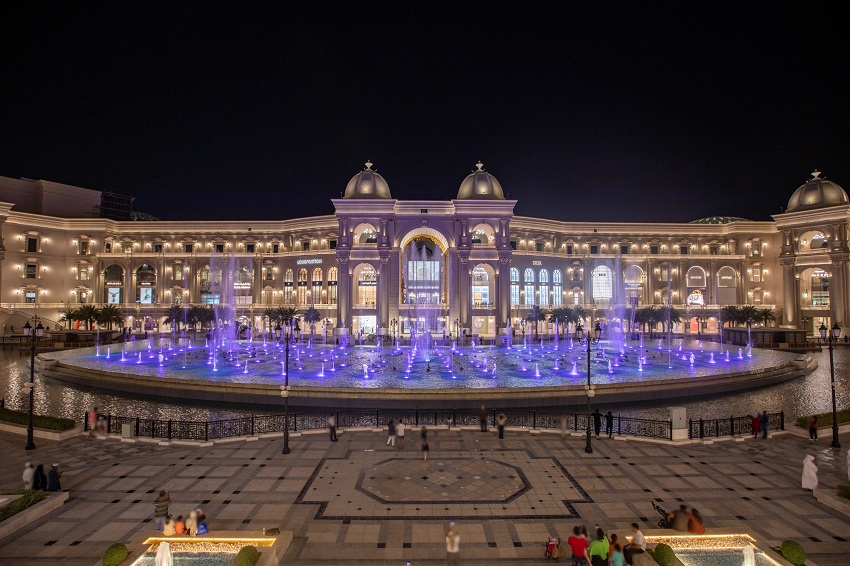
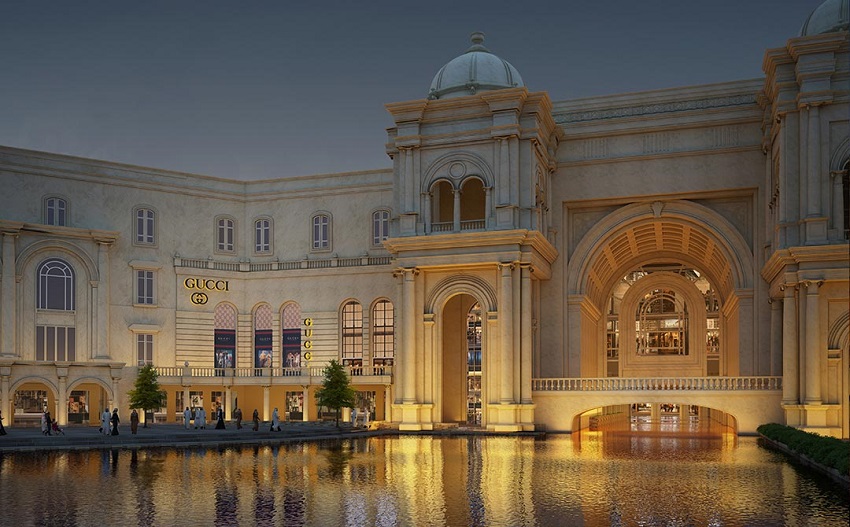

Source Credit: Construction Week Middle East